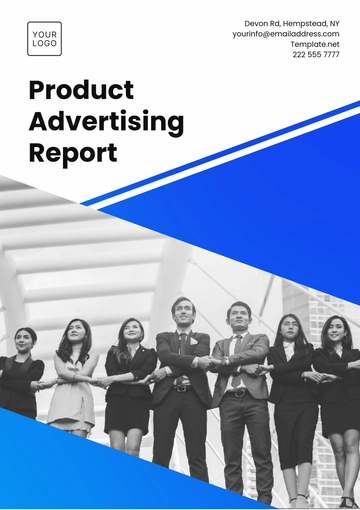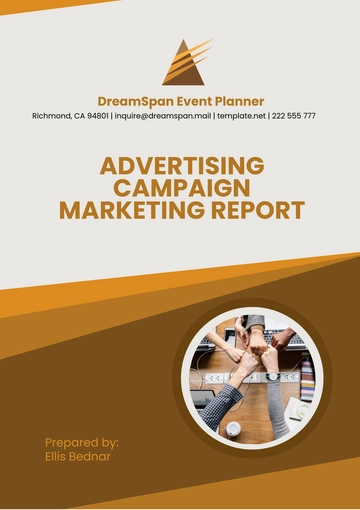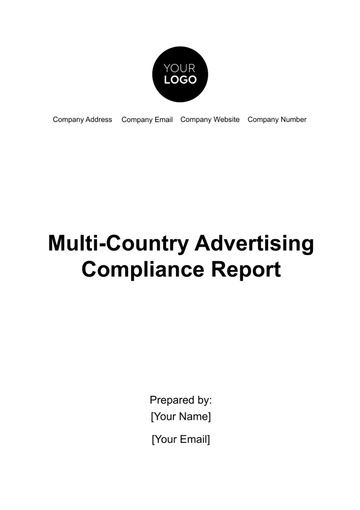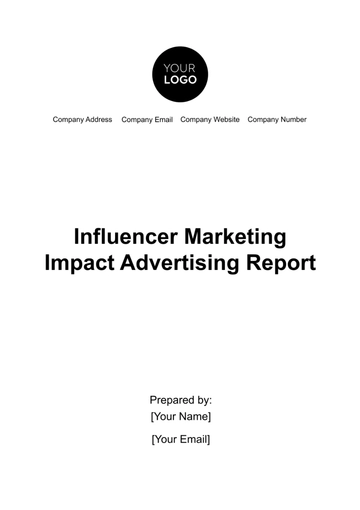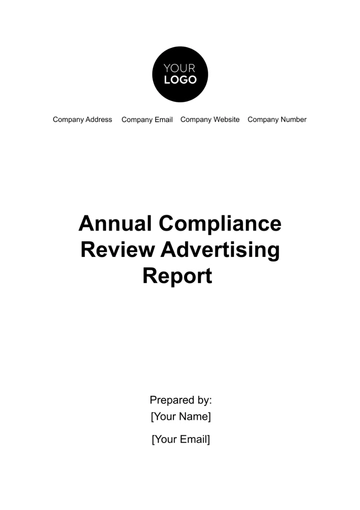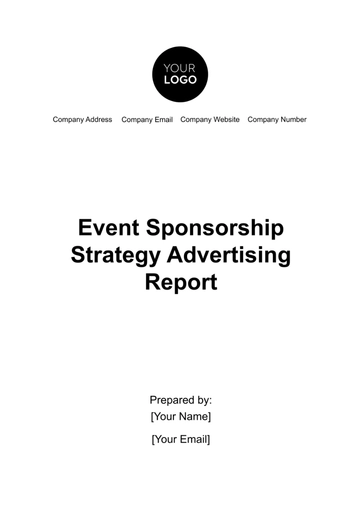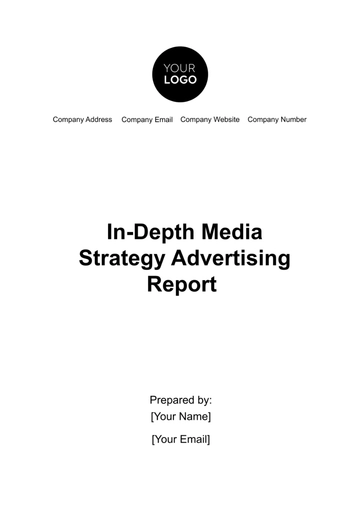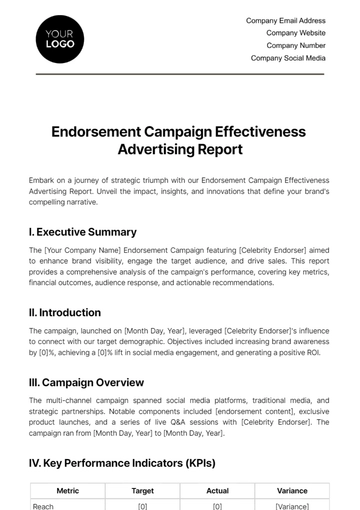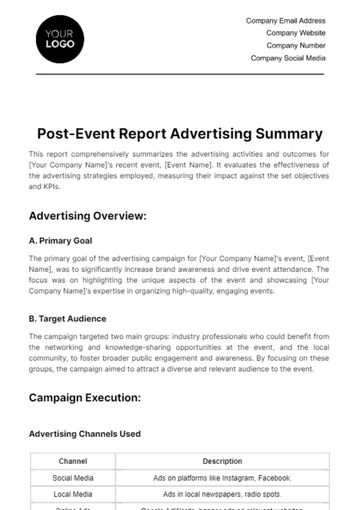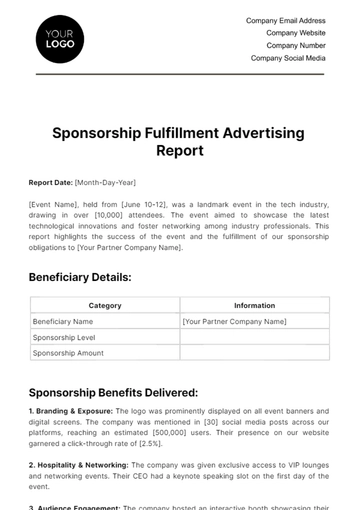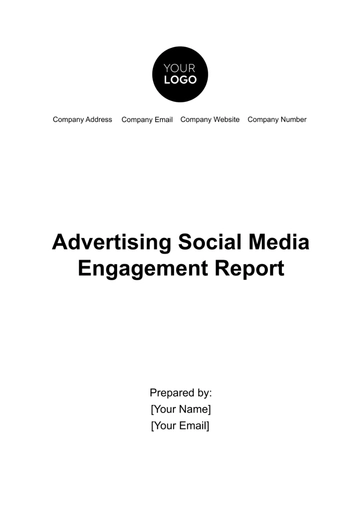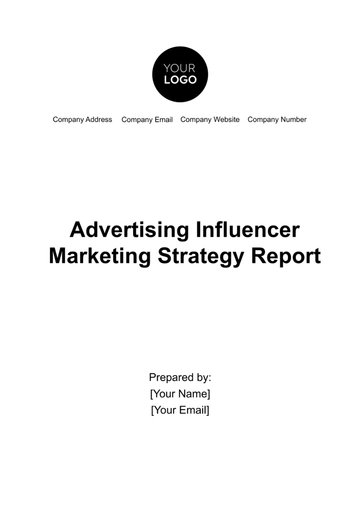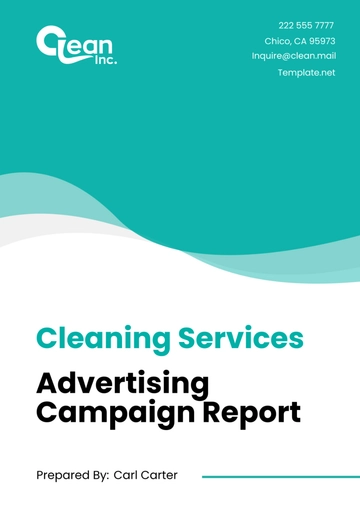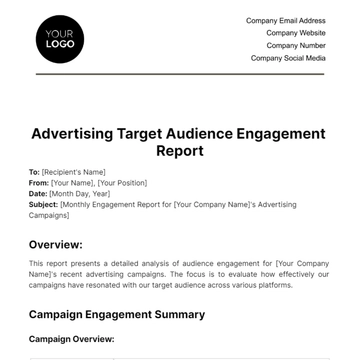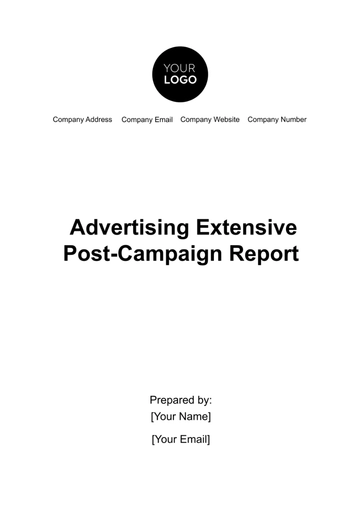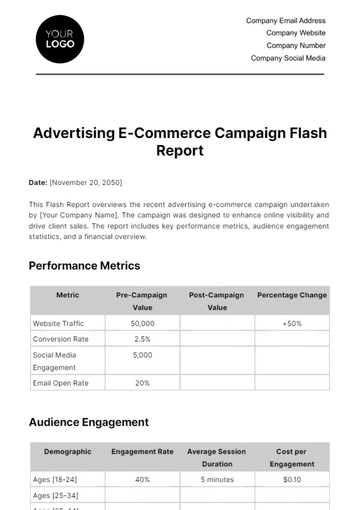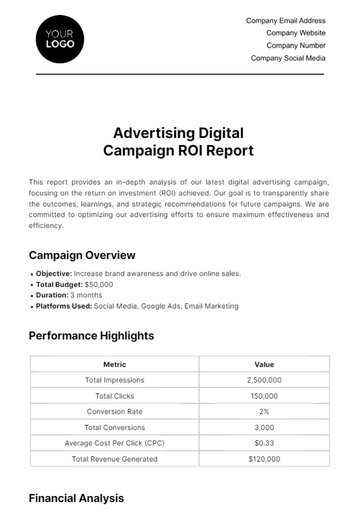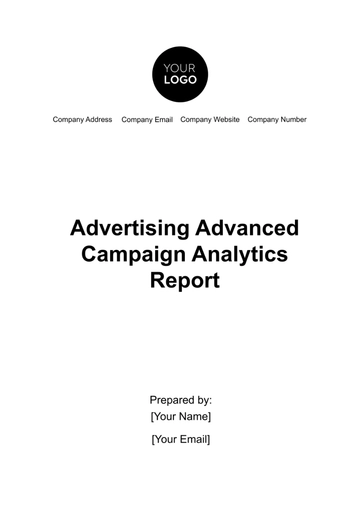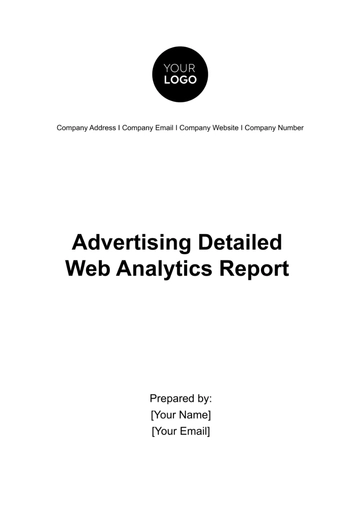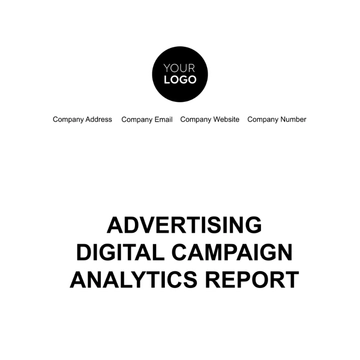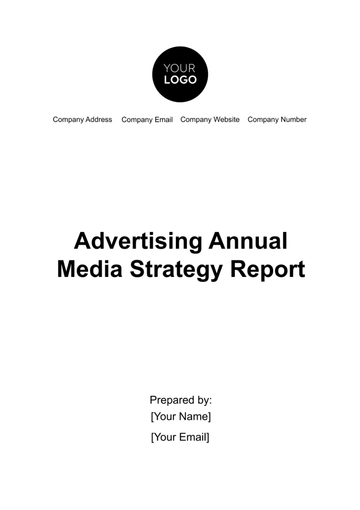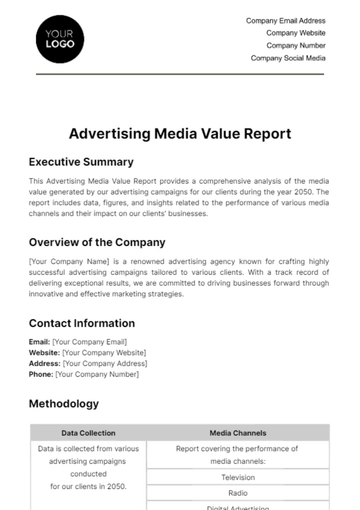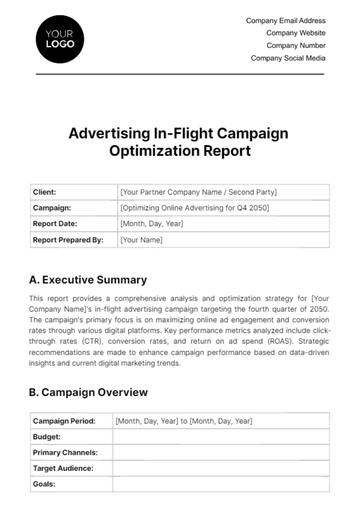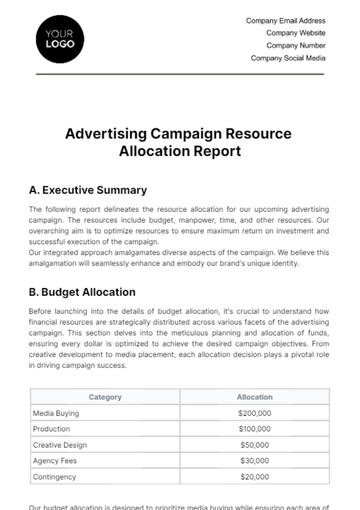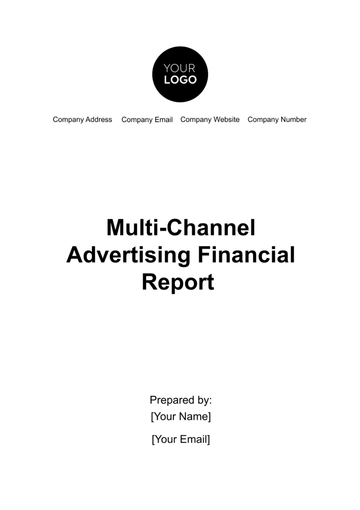Free Cleaning Services Advertising Campaign Report
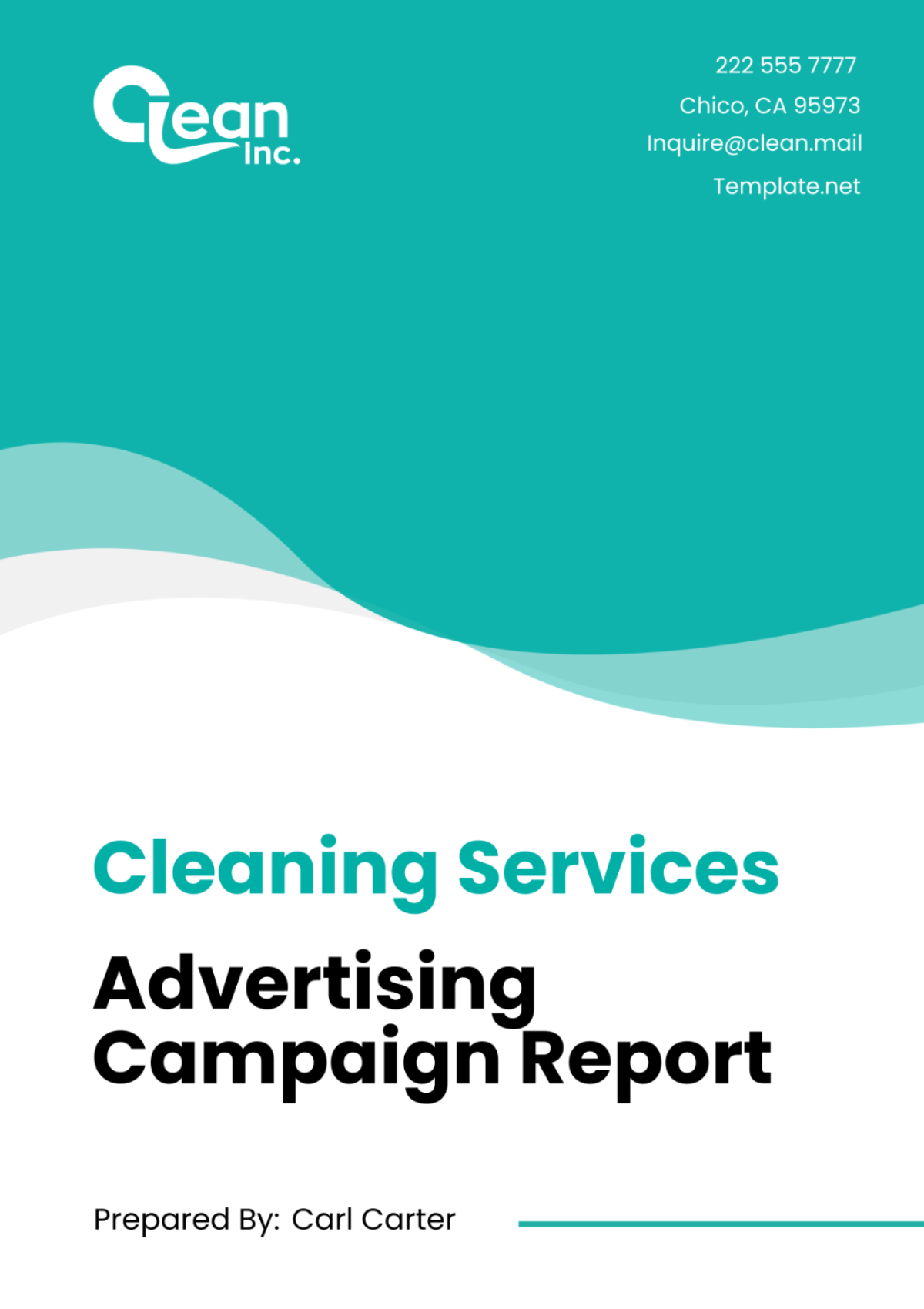
A. Executive Summary
The advertising campaign, designed for [Your Company Name], aimed to increase brand awareness and generate new leads within the United States between [Start Date] and [End Date]. Utilizing a mix of digital and traditional marketing strategies, the campaign sought to engage our target demographic of homeowners aged 30-55 and small business owners in need of professional cleaning services. This summary presents an overview of the objectives, strategies implemented, key findings, and overall performance of the campaign.
B. Introduction
In the competitive cleaning services market of the United States, [Your Company Name] launched an advertising campaign to distinguish itself from competitors, highlight its eco-friendly cleaning solutions, and expand its customer base. The campaign's goals were to enhance online presence, increase service inquiries by 20%, and boost website traffic by 30%.
C. Campaign Overview
Theme and Messaging: "Clean Green: Refresh Your Space and Planet" aimed at eco-conscious consumers prioritizing sustainability.
Target Audience:
Primary | Secondary |
|---|---|
Homeowners aged 30-55 in the United States, with a focus on eco-friendliness. | Small businesses looking for reliable, green cleaning services. |
Platforms Used:
Digital: Facebook, Instagram, Google Ads
Traditional: Local newspapers, community bulletin boards
D. Campaign Strategies
The campaign combined digital storytelling with targeted traditional advertising. Social media platforms were used to share before-and-after project photos, eco-friendly cleaning tips, and customer testimonials. Google Ads targeted high-intent search terms related to eco-friendly cleaning services. Traditional media complemented digital efforts, focusing on community engagement and local visibility.
In addition to the primary digital and traditional marketing mix, the campaign leveraged email marketing to re-engage past customers with special offers and updates about our eco-friendly initiatives. This dual approach of targeting new prospects while nurturing existing relationships aimed to maximize reach and impact. The integration of a storytelling approach, particularly through customer success stories and educational content about the benefits of eco-friendly cleaning, was designed to build trust and establish [Your Company Name] as an authority in sustainable cleaning solutions.
E. Budget Overview
The budget for an advertising campaign is a financial plan that outlines the estimated costs associated with executing marketing strategies and activities over a specific period.
Platform | Allocation | Details |
|---|---|---|
$2,000 | Ads and sponsored posts | |
$1,500 | Influencer collaborations | |
Google Ads | $2,500 | Search and display ads |
Local Newspapers | $1,000 | Weekly ad placements |
Total | $7,000 |
The table serves as a crucial tool for understanding the financial strategy behind the campaign. It shows where the campaign prioritized spending to maximize impact and indicates the diversification of marketing efforts across digital and traditional mediums. By analyzing this breakdown, stakeholders can evaluate the cost-effectiveness of each channel and make informed decisions for future budget allocations based on performance outcomes and ROI.
F. Execution Details
The campaign ran from [Start Date] to [End Date], with a phased approach: initial buzz generation through social media and Google Ads, followed by sustained visibility in local newspapers. Creative assets focused on the "Clean Green" theme, emphasizing the impact of eco-friendly cleaning on home health and the environment.
G. Performance Metrics
Key metrics included:
Impressions and reach
Click-through rate (CTR)
Conversion rate
Lead generation numbers
Data was collected through Google Analytics, social media insights, and direct inquiries attributed to advertising efforts. Beyond the basic metrics of impressions, CTR, and conversion rate, engagement metrics such as likes, shares, comments, and time spent on the website were closely monitored to gauge audience interest and content effectiveness. Advanced tracking via Google Analytics provided insights into user behavior, including the most visited pages, bounce rate, and the path visitors took through the website. These metrics offered a deeper understanding of how well the campaign content resonated with the target audience and drove actions beyond initial clicks.
H. Results and Analysis
The campaign exceeded expectations in generating online engagement and leads. Facebook and Google Ads were particularly effective, with a 35% increase in website traffic and a 25% rise in service inquiries, surpassing the initial goals. Traditional advertising contributed significantly to brand recognition in the local community, though with a lower direct response rate compared to digital platforms.
The campaign's success was also reflected in the qualitative feedback received from the audience. Customers expressed appreciation for the educational content and eco-friendly mission of [Your Company Name], highlighting the impact of authentic engagement on brand perception. Analysis of social media engagement patterns revealed a significant increase in community interactions, including direct messages with inquiries and positive feedback. This qualitative success complemented the quantitative results, indicating a strong alignment between the campaign's messaging and the values of the target audience.
I. Challenges and Solutions
One challenge was lower-than-expected engagement on Instagram. Adjusting the content strategy to include more interactive posts, such as polls and Q&A sessions, improved engagement rates in the latter half of the campaign.
Another challenge encountered was the initial underperformance of Google Ads in terms of conversion rates. A mid-campaign audit revealed issues with ad copy relevance and landing page optimization. By refining ad copy to more directly address the search intent and improving landing page design for a better user experience, the conversion rates improved significantly in the latter half of the campaign. This adjustment underscored the importance of ongoing optimization and the willingness to pivot strategy based on performance data.
J. Lessons Learned
The importance of incorporating flexible strategies in business operations has been clearly demonstrated through the success of digital platforms. It has highlighted the need for businesses to be prepared to modify their strategies or tactics as and when needed. This adjustment is based on performance data that is collected in real-time, enabling businesses to make informed decisions rapidly. Furthermore, the success of digital platforms serves as a testament to the value of effective targeting and retargeting abilities. The capabilities to accurately target potential customers and retarget the ones who have shown interest are invaluable in the increasingly digital world, where competition is high and attention spans are short. The key takeaway is that flexible strategies and precise targeting and retargeting are critical to the success of digital platforms and should be prioritized by businesses aiming to thrive in the digital age.
K. Future Recommendations
For future campaigns, allocate a higher budget to digital advertising, particularly Google Ads and Facebook, given their high performance. Explore additional social media platforms like TikTok to reach a broader audience. Consider a more interactive approach on Instagram to sustain engagement.
Building on the insights gained from this campaign, it's recommended to further explore segmentation and personalization in future marketing efforts. Given the positive response to tailored content, segmenting the audience based on their specific interests, such as pet-friendly cleaning solutions or focus areas within the home, could allow for even more personalized communication.
Additionally, investing in marketing automation tools could streamline these efforts, enabling more efficient and effective targeting. Experimenting with emerging social platforms and technologies, such as augmented reality (AR) for virtual cleanings or demonstrations, could also captivate a younger, tech-savvy audience. Strengthening partnerships with eco-friendly product suppliers for joint promotions could enhance the brand's eco-conscious image and offer additional value to customers. These strategies not only aim to build upon the current campaign's successes but also adapt to changing market trends and consumer expectations, ensuring [Your Company Name] remains at the forefront of the cleaning services industry.
- 100% Customizable, free editor
- Access 1 Million+ Templates, photo’s & graphics
- Download or share as a template
- Click and replace photos, graphics, text, backgrounds
- Resize, crop, AI write & more
- Access advanced editor
Elevate your marketing with the Cleaning Services Advertising Campaign Report Template from Template.net. This template, customizable and editable via an AI Editor Tool, enables a detailed analysis of your advertising efforts. Tailored for the cleaning industry, it facilitates the assessment of campaign effectiveness. Unlock the potential of your marketing strategies exclusively at Template.net.
You may also like
- Sales Report
- Daily Report
- Project Report
- Business Report
- Weekly Report
- Incident Report
- Annual Report
- Report Layout
- Report Design
- Progress Report
- Marketing Report
- Company Report
- Monthly Report
- Audit Report
- Status Report
- School Report
- Reports Hr
- Management Report
- Project Status Report
- Handover Report
- Health And Safety Report
- Restaurant Report
- Construction Report
- Research Report
- Evaluation Report
- Investigation Report
- Employee Report
- Advertising Report
- Weekly Status Report
- Project Management Report
- Finance Report
- Service Report
- Technical Report
- Meeting Report
- Quarterly Report
- Inspection Report
- Medical Report
- Test Report
- Summary Report
- Inventory Report
- Valuation Report
- Operations Report
- Payroll Report
- Training Report
- Job Report
- Case Report
- Performance Report
- Board Report
- Internal Audit Report
- Student Report
- Monthly Management Report
- Small Business Report
- Accident Report
- Call Center Report
- Activity Report
- IT and Software Report
- Internship Report
- Visit Report
- Product Report
- Book Report
- Property Report
- Recruitment Report
- University Report
- Event Report
- SEO Report
- Conference Report
- Narrative Report
- Nursing Home Report
- Preschool Report
- Call Report
- Customer Report
- Employee Incident Report
- Accomplishment Report
- Social Media Report
- Work From Home Report
- Security Report
- Damage Report
- Quality Report
- Internal Report
- Nurse Report
- Real Estate Report
- Hotel Report
- Equipment Report
- Credit Report
- Field Report
- Non Profit Report
- Maintenance Report
- News Report
- Survey Report
- Executive Report
- Law Firm Report
- Advertising Agency Report
- Interior Design Report
- Travel Agency Report
- Stock Report
- Salon Report
- Bug Report
- Workplace Report
- Action Report
- Investor Report
- Cleaning Services Report
- Consulting Report
- Freelancer Report
- Site Visit Report
- Trip Report
- Classroom Observation Report
- Vehicle Report
- Final Report
- Software Report
